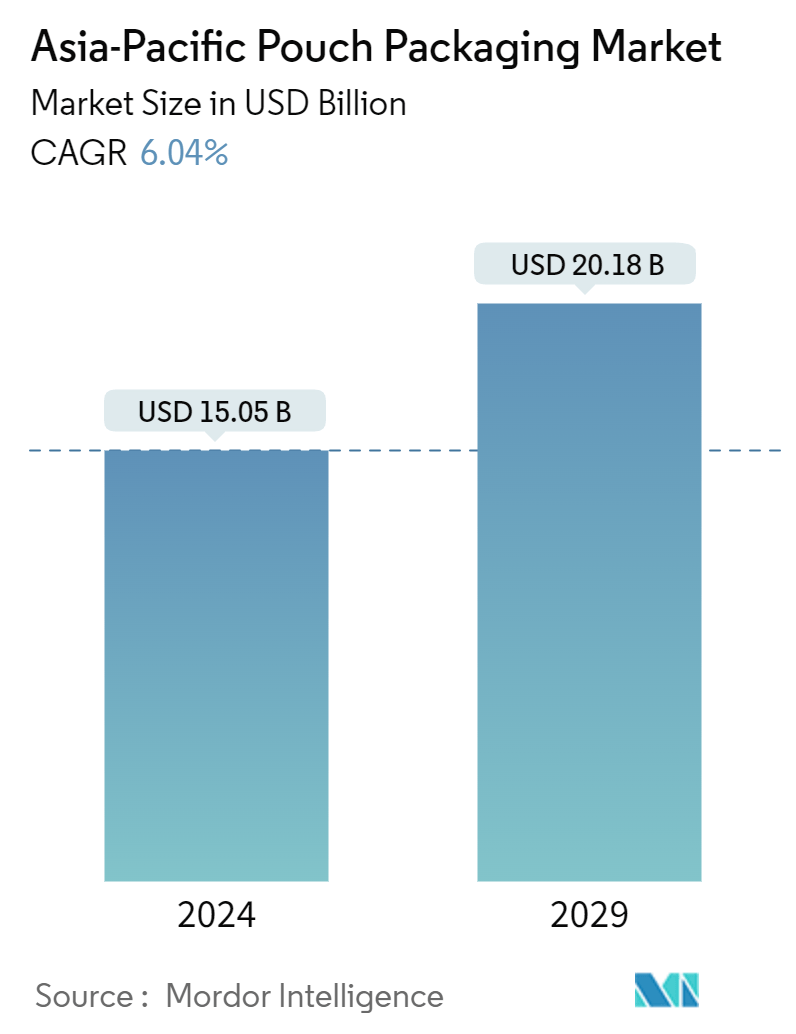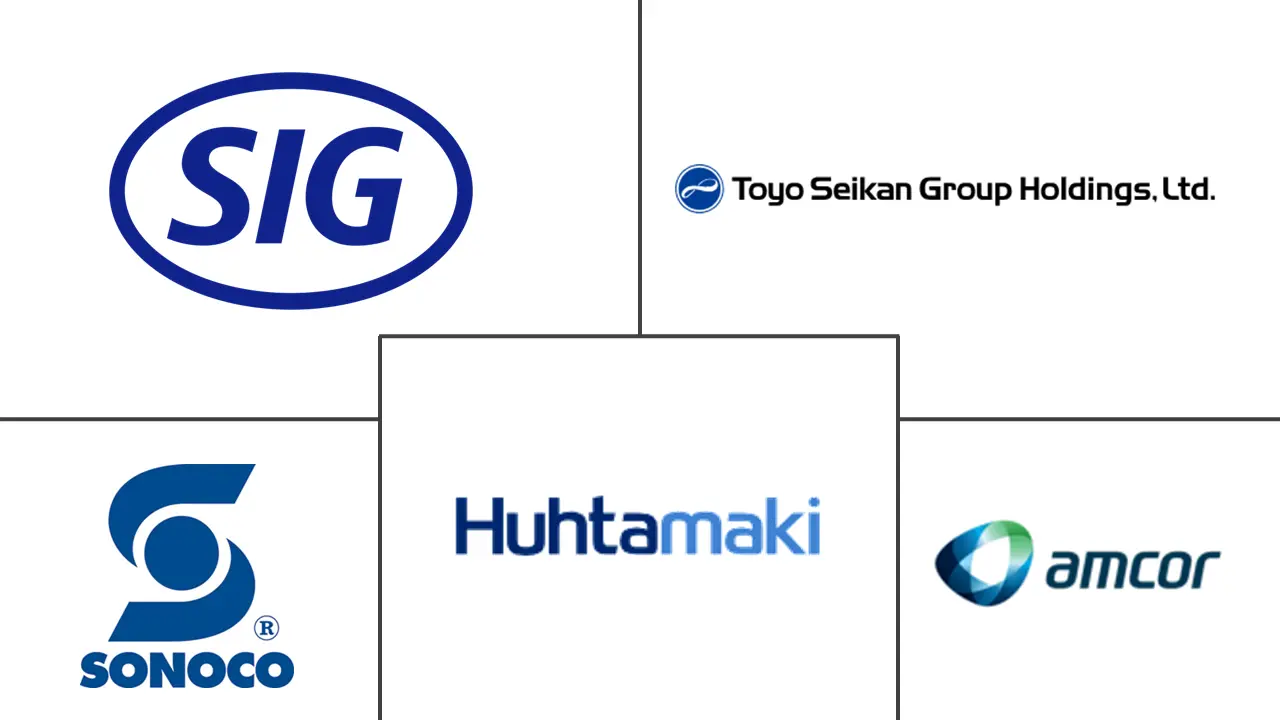Market Size of Asia-Pacific Pouch Packaging Industry

| Study Period | 2019 - 2029 |
| Base Year For Estimation | 2023 |
| Market Size (2024) | USD 15.05 Billion |
| Market Size (2029) | USD 20.18 Billion |
| CAGR (2024 - 2029) | 6.04 % |
| Market Concentration | Low |
Major Players
*Disclaimer: Major Players sorted in no particular order |
Asia-Pacific Pouch Packaging Market Analysis
The Asia-Pacific Pouch Packaging Market size is estimated at USD 15.05 billion in 2024, and is expected to reach USD 20.18 billion by 2029, growing at a CAGR of 6.04% during the forecast period (2024-2029). In terms of shipment volume, the market is expected to grow from 180.63 billion units in 2024 to 230.28 billion units by 2029, at a CAGR of 4.98% during the forecast period (2024-2029).
- Pouch packaging, utilizing materials like plastic films, aluminum foil, or laminates, caters to specific needs such as barrier properties, durability, and visual appeal. Stand-up pouches, designed for products like snacks and liquids, boast a self-supporting base. Conversely, flat pouches cater to compact items like spices, while spouted pouches facilitate easy pouring for liquids such as sauces or baby food. Sealing methods, like heat sealing, ensure meticulous protection from external elements. Some pouches even sport zipper closures, enhancing user convenience and preserving product freshness, all in line with the rising consumer demand for convenience.
- Across the Asia-Pacific region, processed foods, including ready-to-eat meals and snacks, are gaining traction, driven by the region's increasingly busy lifestyles. The World Health Organization notes a significant shift in dietary patterns in Southeast Asia, with a growing preference for highly processed and out-of-home foods. Given their barrier properties and resealable features, pouch packaging emerges as the go-to choice for these convenience-driven processed foods. Single-serving pouches are particularly popular for portion-controlled snacks, aligning well with the needs of on-the-go consumers.
- Notably, in the Asia-Pacific region, retort pouches, alongside aseptic pouches, are witnessing a surge in popularity. These pouches, designed for products ranging from processed meals to pet food, are engineered to endure high-temperature processing, ensuring prolonged freshness and quality. Their multi-layered construction offers varying levels of protection, often outperforming traditional packaging like cans or jars.
- Consumer preferences are a key driver for the rising demand for pouch packaging. Ongoing innovations in design and materials ensure pouches evolve, offering enhanced functionality and convenience. For instance, in March 2023, Shokubutsu Monogatari, a Japanese beauty care brand under Lion Corp., unveiled a 100% recyclable pouch for its shower cream refills. This innovative pouch, crafted from a mono-material, features a polyethylene film produced through tenter-frame biaxial orientation.
- With superior barrier properties, pouches effectively shield their contents from moisture, oxygen, light, and contaminants, extending the shelf life of products like food, pharmaceuticals, and cosmetics. Their lightweight nature not only reduces transportation costs but also aligns with sustainability goals, especially as pouches increasingly utilize recyclable materials. Additionally, the ample branding space on pouches aids in reinforcing brand identity, helping products stand out on shelves.
Asia-Pacific Pouch Packaging Industry Segmentation
Pouch packaging is a flexible packaging product made from barrier films or paper or foil, depending on the end-user’s requirement. This report analyzes the factors that impact geopolitical developments in the market studied based on the prevalent base scenarios, key themes, and end-user industries-related demand cycles. The analysis is based on the market insights captured through secondary research and the primaries. The market also covers the major factors impacting the growth of the pouch market in terms of drivers and restraints. The estimates exclude the weight and the cost of the content that is or is to be packed inside the pouch packaging solution.
The Asia-Pacific pouch packaging market is segmented by material type (paper, plastic, and aluminum), resin type - plastic (polyethylene, polypropylene, PET, PVC, EVOH, and other resins), product (flat [pillow and side seal] and stand up), type (standard, aseptic, retort, and hot fill), end-user industry (food [candy and snack food, processed food, fresh produce, dairy products, pet food, meat, poultry, seafood, and other food products], medical and pharmaceutical, personal care and household care, and other end-user industries), and country (China, Japan, India, South Korea, Australia and New Zealand, Thailand, Indonesia, Vietnam, and Rest of Asia-Pacific). The market sizes and forecasts are provided in terms of value (USD) and volume (Units) for all the above segments.
| By Material | ||||||||
| ||||||||
| Paper | ||||||||
| Aluminum |
| By Type | |
| Standard | |
| Aseptic | |
| Retort | |
| Hot Fill |
| By Product | |
| Flat (Pillow & Side-Seal) | |
| Stand-up |
| By End-User Industry | ||||||||||
| ||||||||||
| Medical and Pharmaceutical | ||||||||||
| Personal Care and Household Care | ||||||||||
| Other End user Industries (Automotive, Chemical, Agriculture) |
| ByCountry |
Asia-Pacific Pouch Packaging Market Size Summary
The Asia-Pacific pouch packaging market is experiencing significant growth, driven by the increasing demand for convenience and efficiency in packaging solutions. Pouch packaging, which includes stand-up, flat, and spouted pouches, is favored for its barrier properties, durability, and visual appeal, making it ideal for a variety of products such as snacks, liquids, and processed foods. The region's busy lifestyles have led to a rise in processed foods, with pouch packaging emerging as the preferred choice due to its resealable features and ability to extend shelf life. The market is also witnessing a surge in the popularity of retort and aseptic pouches, which are designed to withstand high-temperature processing, ensuring product freshness and quality. Innovations in design and materials continue to enhance the functionality and convenience of pouches, aligning with consumer preferences for sustainable and user-friendly packaging solutions.
The demand for pouch packaging is further bolstered by the food and beverage industry's shift towards aseptic packaging, which offers longer shelf life and sustainability. The pharmaceutical sector also relies on aseptic pouches for maintaining sterility in liquid medications and other sterile products. The expansion of the food processing industry in countries like India, coupled with the rise in milk production, is driving the need for pouch packaging to preserve quality and extend shelf life. The market is characterized by the presence of both domestic and global players, such as Toppan Holdings Inc., Toyo Seikan Co. Ltd, Amcor Group GmbH, and Sonoco Products Company, who are actively engaging in mergers, acquisitions, and product launches to strengthen their market position. Recent collaborations and innovations, such as the introduction of recyclable pouches and new production facilities, underscore the industry's commitment to sustainability and meeting the evolving demands of consumers.
Asia-Pacific Pouch Packaging Market Size - Table of Contents
-
1. MARKET INSIGHTS
-
1.1 Market Overview
-
1.2 Industry Attractiveness - Porter's Five Forces Analysis
-
1.2.1 Bargaining Power of Suppliers
-
1.2.2 Bargaining Power of Buyers
-
1.2.3 Threat of New Entrants
-
1.2.4 Threat of Substitutes
-
1.2.5 Intensity of Competitive Rivalry
-
-
1.3 Industry Value Chain Analysis
-
-
2. MARKET SEGMENTATION
-
2.1 By Material
-
2.1.1 Plastic
-
2.1.1.1 Polyethylene
-
2.1.1.2 Polypropylene
-
2.1.1.3 PET
-
2.1.1.4 PVC
-
2.1.1.5 EVOH
-
2.1.1.6 Other Resins
-
-
2.1.2 Paper
-
2.1.3 Aluminum
-
-
2.2 By Type
-
2.2.1 Standard
-
2.2.2 Aseptic
-
2.2.3 Retort
-
2.2.4 Hot Fill
-
-
2.3 By Product
-
2.3.1 Flat (Pillow & Side-Seal)
-
2.3.2 Stand-up
-
-
2.4 By End-User Industry
-
2.4.1 Food
-
2.4.1.1 Candy & Confectionery
-
2.4.1.2 Frozen Foods
-
2.4.1.3 Fresh Produce
-
2.4.1.4 Dairy Products
-
2.4.1.5 Dry Foods
-
2.4.1.6 Meat, Poultry, and Seafood
-
2.4.1.7 Pet Food
-
2.4.1.8 Other Food Products
-
-
2.4.2 Medical and Pharmaceutical
-
2.4.3 Personal Care and Household Care
-
2.4.4 Other End user Industries (Automotive, Chemical, Agriculture)
-
-
2.5 ByCountry
-
2.5.1
-
2.5.1.1 China
-
2.5.1.2 India
-
2.5.1.3 Japan
-
2.5.1.4 Thailand
-
2.5.1.5 Australia and New Zealand
-
2.5.1.6 Indonesia
-
2.5.1.7 Vietnam
-
2.5.1.8 Rest of Asia-Pacific
-
-
-
Asia-Pacific Pouch Packaging Market Size FAQs
How big is the Asia-Pacific Pouch Packaging Market?
The Asia-Pacific Pouch Packaging Market size is expected to reach USD 15.05 billion in 2024 and grow at a CAGR of 6.04% to reach USD 20.18 billion by 2029.
What is the current Asia-Pacific Pouch Packaging Market size?
In 2024, the Asia-Pacific Pouch Packaging Market size is expected to reach USD 15.05 billion.

